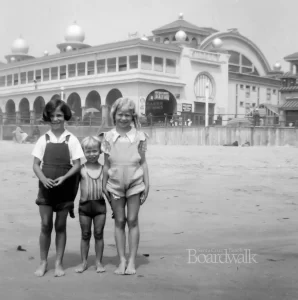The Boardwalk’s iconic Giant Dipper is 95 years young on May 17, 2019. This blog recounts the little-known history of our roller coaster’s origin and the dismal economic ups-and-downs of its initial decade of operation that almost provoked its proprietor to remove it from the Boardwalk.
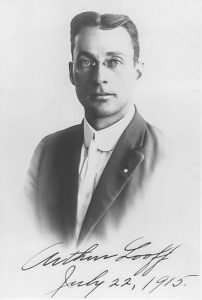
The story of our iconic Giant Dipper begins with the Looff family, a prominent amusement industry family. Charles I.D. Looff, a Danish immigrant, was an acclaimed east coast carousel designer and manufacturer in the late 1800s. His youngest son Arthur was already a mainstay in his father’s carousel factory at the age of 16. Attracted to new activity at up-and-coming Pacific coast amusement parks, the Looff family relocated to Long Beach, CA in 1910. From there, Charles continued to produce his iconic carousels. One of his creations opened at the Santa Cruz Boardwalk in August 1911. Arthur worked in the family business which was expanding beyond carousels into other amusement diversions, like roller coasters.
In 1913, 25-year-old Arthur managed the installation of a new carousel for San Francisco’s Ocean Beach, a nascent entertainment area at the city’s far-western reach.

Arthur soon established a successful Ocean Beach partnership with John Friedle, a concessionaire at the embryonic amusement zone. Within eight years, the two colleagues were running ten rides and more games and concessions. Their Shoot-the-Chutes became so popular the amusement complex became identified as Chutes-at-the-Beach. As time wore on, the popular destination warranted more ride experiences.
In 1922, Arthur crowned his enterprise with his first Big Dipper roller coaster.
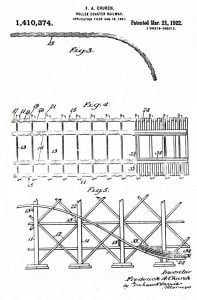
One biographer described Arthur Looff as a soft-spoken, teetotaling gentleman who regularly wore a tie and two wristwatches—one keeping proper time and the other a stopwatch. A self-trained engineer, Looff also had an inborn knack for business. His gentle, unpretentious and non-argumentative nature made his zeal for coasters a puzzle. He built his Big Dipper roller coaster with his own crew. However, he integrated an innovative track system perfected by the gravity coaster design team of Prior & Church. This partnership had patented a unique wheel and track design a year previously that guaranteed greater operational safety. Business-minded Looff envisioned his “double-out-and-back” San Francisco roller coaster might be the first of others he’d replicate.
It turns out, all was not well within the Chute’s Park partnership, however. Looff and Friedle enjoyed a rewarding relationship; their wives did not. Unguarded quarreling and bitterness occurred between their spouses. It seemed the only way mild-mannered Arthur could preserve harmony at home was for the colleagues to separate. They did. In 1923, Looff sold his interest in their partnership to Friedle. It would be a few more years before that San Francisco amusement area would become “Playland-at-the-Beach.”
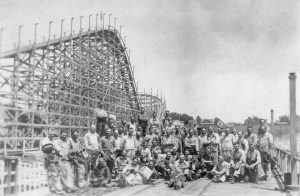
With less attention now demanded in San Francisco, and with cash in the bank arising from ending his partnership with Friedle, Arthur Looff fixed his eyes on Santa Cruz. In August 1923, he approached Santa Cruz Seaside Company management with a proposition. He offered to replace the Boardwalk’s worn-out Scenic Railway coaster with a gravity coaster to keep pace with roaring twenties exuberance. Negotiations ensued, and in December Looff signed a lease to erect his second coaster. A $10,000 escrow deposit assured the Boardwalk of Looff’s commitment to building a Giant Dipper and Looff became a Boardwalk concessionaire.
Perhaps some homage is due to Mrs. Looff and Mrs. Friedle for their roles in turning Arthur’s attention toward Santa Cruz Beach when he did.

Local citizens expectantly eyed progress at the beachfront. The Scenic Railway’s structure came down. In January 1924, the Santa Cruz Evening News proclaimed, “According to Mr. Looff the new dipper will have no superior in the United States and will provide thrills for the riders that are not experienced on the ordinary scenic railway.” In February, that same paper affirmed, “Arthur Looff, the owner and builder, is one of the foremost men in the amusement world of the Pacific coast, with a long record of successful operations. The amusement devices he has built have shown continuous improvement so that we are assured of the very latest and most thrilling ride on the coast.”
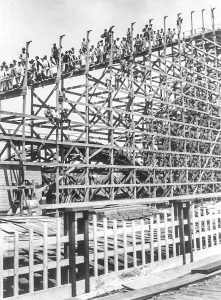
By mid-March, two water-borne schooners had delivered their cargoes of lumber for the ride. By month’s end and with a load of bolts and nails, steel track, concrete, and paint on hand, Looff had assembled a 50-man construction team. Work promptly started on his ride’s creation on April 1. In the 47 days that followed, the ride took shape, dwarfing the contour of its Scenic Railway predecessor. It took around $60,000 to bring it all together, about $870,000 in today’s dollars.
Our coaster was Looff’s passion and his most beautiful work. Boardwalk archival records substantiate that the team of Prior & Church provided the trains and conceived the ride’s comprehensive design. Looff titled the ride his Giant Dipper.
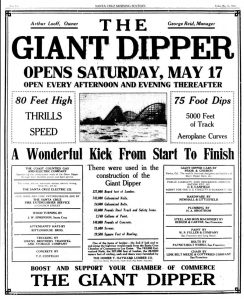
In the week before opening day, spectators saw workers trying out the ride to reveal mechanical or construction defects. Curiosity seekers witnessed the clamor of three coaster trains, of ten cars each, running steadily for 10-hours on Friday, May 16 to test out new parts and the safety of the track.
One news report disclosed that very early the next day, a 200-foot long line of eager, prospective riders had assembled to assure themselves an Opening Day adventure on Looff’s new ride for 15¢. Late on Saturday, May 17, 1924, the Giant Dipper officially opened, and beach-goers heard the screams of excited riders throughout the shoreline. The Seaside Company augmented grand opening festivities too. It offered a special dinner at the Casino Coffee Shop followed by a jubilant dance in the Casino Ballroom.
Extending his 17-year association with Arthur Looff, George Reid became the ride’s resident manager. His family moved into a seven-room house that Looff provided, next to the ride’s starting deck and between the railroad tracks and the Boardwalk.
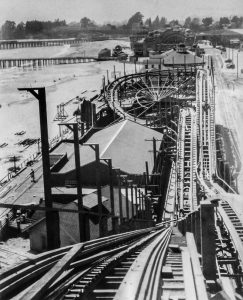
The Giant Dipper’s acclaim and ridership grew in its first several years. Mid-summer 1927, the Santa Cruz Evening News headlined an article “Giant Dipper is Magnet on Lower Midway” and stated that the section of the Boardwalk surrounding the ride “…is as lively a midway as the section immediately surrounding the Casino…” However, ride attendance and resulting revenues leveled off in 1928. It’s conceivable the opening of the Boardwalk’s River Park that year with its Shoot-the-Chutes competed with Dipper ridership.
In September 1929, Looff revealed to Seaside Company officials that he still had not recouped his initial construction cost. At his present rate of business, he foresaw it would be several more years before this would result. A disappointed Looff sought a lease adjustment and operational modifications to boost the ride’s profitability and cash flow.
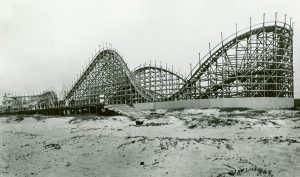
A month later, the nation’s stock market suffered its fateful crash.
Giant Dipper revenues dropped 26% in 1930 over its preceding and best year. The ensuing recession doomed the Boardwalk’s River Park Chutes that year, too. Looff incorporated his Giant Dipper business into the Santa Cruz Giant Dipper Company, Ltd, wanting to save on taxes and maybe to stir up additional investment.
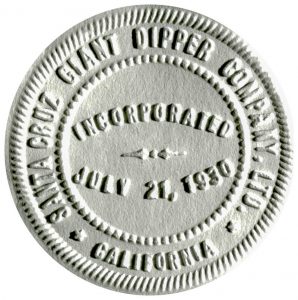
Further decreases in Giant Dipper revenue followed. In 1932, Looff’s earnings declined to a third of a few years earlier. Reflecting the foreboding financial outlook, in January 1933 he sought a substantial rent reduction for his ride. He stated that if he could not secure better lease terms, he would not exercise the five year extension on his lease, an option available for him at the agreement’s termination on July 31, 1933. Seaside Company management responded by affording a more favorable rent formula for Looff, provided he accept his five-year lease extension.
But five more years of financial insecurity did not appeal to Looff. He threatened to remove his Giant Dipper at the termination of its lease. His lease permitted this, it was his ride!
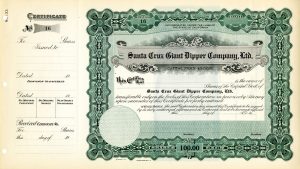
In a March 1933 letter, he declared his intention to disassemble the ride and move on. He stated, “…. it leaves us with but one course to pursue and that is, to remove the Giant Dipper upon the expiration of the present lease term…The money we receive from the salvage value of the ride we propose to invest in a proposition in Long Beach that will net a greater return than operating in Santa Cruz….”
Within two months, alarmed Seaside Company managers reacted to Looff’s threat by confirming their interest in buying his Giant Dipper. With summer nigh upon it, the Seaside Company board of directors negotiated terms for the deal acceptable to Looff. On June 5, 1933, the beach company acquired all outstanding shares of Santa Cruz Giant Dipper Company stock and commenced operating the ride. In July and August that summer, ridership surpassed that of those two months in the preceding year, a reassuring prospect for the Dipper’s future outlook. In the ensuing decades, our signature ride has attracted millions of Boardwalk thrill-seekers.
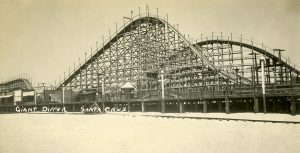
Thirty years later, in a letter to venerable Boardwalk historian Skip Littlefield in December 1962, Arthur Looff acknowledged he could not cite the exact year his Santa Cruz Giant Dipper opened, its initial cost to build, or what the Seaside Company paid for the ride. He revealed he’d thrown away all his original papers and plans for the ride. Perhaps this signaled his Giant Dipper had developed into a vague memory clouded by Looff’s more lucrative projects in the ensuing years.
Former Seaside Company President Laurence Canfield stated in 1971, “I enjoyed the Giant Dipper as a kid—now my grandchildren head that direction on every visit to the Boardwalk—it was—and still is—and probably will always remain the most popular ride at the seashore.” The generational nostalgic appeal of our Giant Dipper has fulfilled Canfield’s prediction. Today’s Boardwalk guests can still enjoy the same classic coaster their grandparents did.
Looff did not live to see his Giant Dipper declared a National Historic Landmark in 1987. Nor did he realize that his Giant Dipper became the crown jewel of the Boardwalk and a Santa Cruz icon. Today the ride is the fourth oldest wooden coaster in the country continuously operating in its original location.
On May 17, 2019 our Giant Dipper celebrates its 95th year at the Boardwalk. 66 million guests (as of 2024 the number is 68 million) have ridden the classic scream-inducing thrill ride since opening day. Because of the dedicated attention of specialized coaster mechanics, our ride promises to excite guests for many decades to come.
‘till next time –
Ted
archives@beachboardwalk.com



